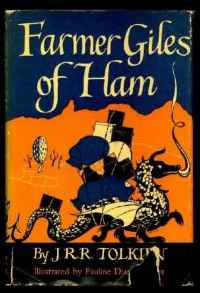|
Tolkien suggests in "On
Fairy-Stories" that the magic of the world of FaŽrie must not be
mocked, even if comic elements are present in the story:
Faerie itself may
perhaps most nearly be translated by Magic - but it is magic of a
peculiar mood and power, at the furthest pole from the vulgar devices of
the laborious, scientific, magician.
There is one proviso: if there is any satire present in the tale,
one thing must not be made fun of, the magic itself.
That must in that story be taken seriously neither laughed at nor
explained away.
In part, he believes this is so because true FaŽrie
requires readers who desire the magic of its world and believe, which is
not the same as a suspension of disbelief. The world must, indeed, be
desirable for it to work its charm. Farmer Giles of Ham, while it originated
in the 1920's as a tale for Tolkien's children, much like Roverrandom
or Mr. Bliss, was expanded by 1938 into a tale that clearly
included mock elements which a learned society, such as the Lovelace
Society, could appreciate. And by its publication in 1949, it had acquired
the mock-scholarly forward and the delightful comic illustrations by
Pauline Baynes. It had clearly become a tale appreciated best on a number
of levels. The Russian literary theorist Mikhail
M. Bakhtin has observed that mock-genres tend to bring a realistic
corrective to the more idealistic works they parody. Mock genres reduce
the hallowed distance that a work like an epic, tragedy, or grand romance
introduce to hold readers in its power. Instead, their laughter brings the
foibles of life up-close for examination:
As a distanced image a subject cannot be
comical; to be made comical, it must be brought close. Everything that
makes us laugh is close at hand, all comical creativity works in a zone
of maximal proximity. Laughter has the remarkable power of making an
object up close, of drawing it into a zone of crude contact where one
can finger it familiarly on all sides, turn it upside down, inside out,
peer at it from above and below, break open its external shell, look at
its center, doubt it, take it apart, dismember it, lay it bare and
expose it, examine it freely and experiment with it. . . . Parodic-travestying
literature introduces the permanent corrective of laughter, of a
critique on the one-sided seriousness of the lofty direct word, the
corrective of reality that is always richer, more fundamental and most
importantly too contradictory and heteroglot to be fit into a
high and straightforward genre.
In other words, parodies, mock-genres,
force us to see the complex, contradictory nature of life as it is really
lived. The literary world that is Farmer Giles is not the same as most of
Tolkien's literary fiction. It is a medieval world set somewhere in
9th-century England, though one not easily identified on any map. It is
not the Middle-Earth of The Silmarillion, The Hobbit, or LOR. What then,
if any, is relationship of these two fictional worlds?
              
Discussion Questions
- Should Farmer Giles of Ham be
classified as a fairy-story? Why or why not?
- Likewise, does it possess any elements
of Faerie? Why or why not?
- Is it classifiable as a genre or
mock-genre?
- Can the plot, characterization, and/or
setting of Farmer Giles be said to possess the heteroglossiac
qualities that Bakhtin attributes to parody? Explain.
- How does Tolkien's story compare with
the world of The Silmarillion?
- Is its humor comparable to that in The
Hobbit or LOR?
- Should Giles be understood as a comic
hero? What kind of world does that imply?
- How (or where) does Farmer Giles
fit into Tolkien's poetics? (cf. "Mythopoeia")

|

